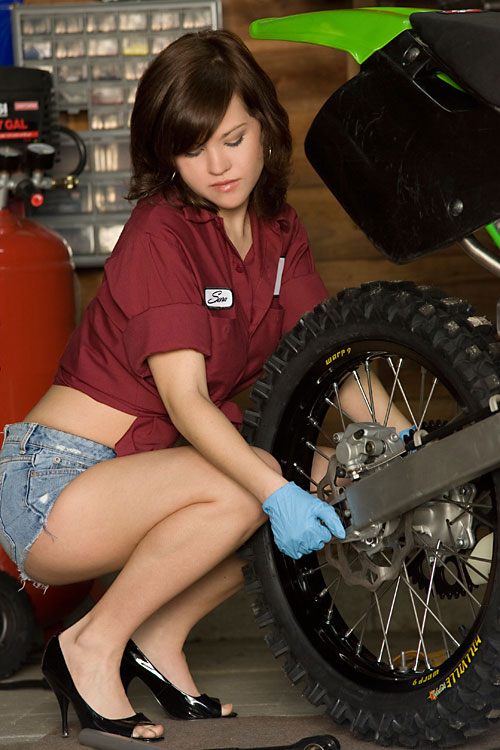Upload
#MyTeacherWins #EatFreshRefresh #NeverStopExploring #rednecklife @bigttatum
455 Likes, 19 Comments. TikTok video from MrscrazyMakayla (@mrscrazymakayla): "#MyTeacherWins #EatFreshRefresh #NeverStopExploring #rednecklife @bigttatum". Trying to get a old Tractor tire back on the rim. the ground was wet also…. just sayin…before hand. Also it’s my daddy’s old tractor please don’t hate! we bought it when I was 8! . Redneck Life.
39.7K views|
*Part 1* when the tire falls off the rim on the tractor 🚜 I couldn't believe this worked last time. After it worked so well there was no way we couldn't record it this time. #cowgirlboots #foryou #4u #redhead #outonthefarm #learning #tractor #fixit
714 Likes, 7 Comments. TikTok video from Smokin.Ginger (@smokin.ginger): "*Part 1* when the tire falls off the rim on the tractor 🚜 I couldn't believe this worked last time. After it worked so well there was no way we couldn't record it this time. #cowgirlboots #foryou #4u #redhead #outonthefarm #learning #tractor #fixit". Part 1 | The tire fell off the rim! | I'll show you how to fix it🤠 | .... Rodeo (Garth Brooks).
14.9K views|
hard work pays off🔥#jamorant #nba #foryou #fyp #viral
69.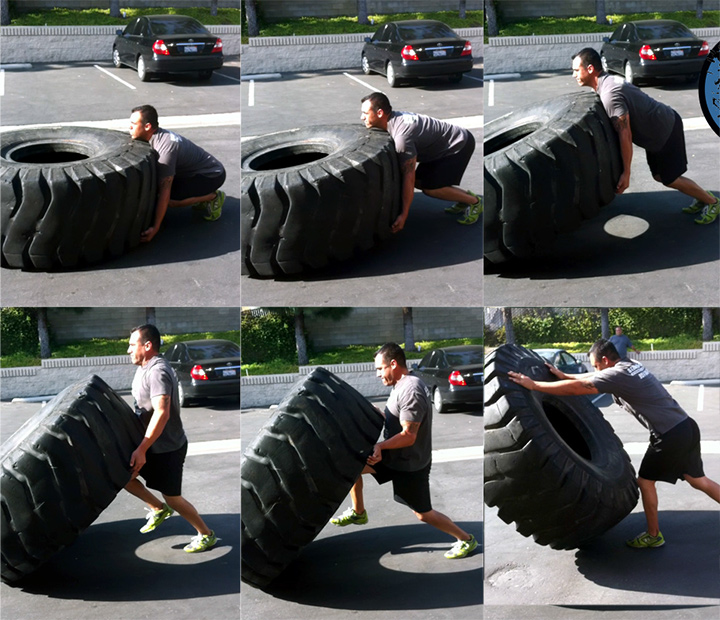 1K Likes, 148 Comments. TikTok video from _kyrieprodz (@_kyrieprodz): "hard work pays off🔥#jamorant #nba #foryou #fyp #viral". suono originale.
1K Likes, 148 Comments. TikTok video from _kyrieprodz (@_kyrieprodz): "hard work pays off🔥#jamorant #nba #foryou #fyp #viral". suono originale.
442.2K views|
#mamaspetservices #MakeMomSmile #gotthisforyou #foryou #foryourpage #fyp #skilledtrades #tractor #onetirefire
276 Likes, 6 Comments. TikTok video from Winnieof502 (@winnieof502): "#mamaspetservices #MakeMomSmile #gotthisforyou #foryou #foryourpage #fyp #skilledtrades #tractor #onetirefire". Pop a tire back on the rim | Starter fluid | Flame | .... original sound.
15K views|
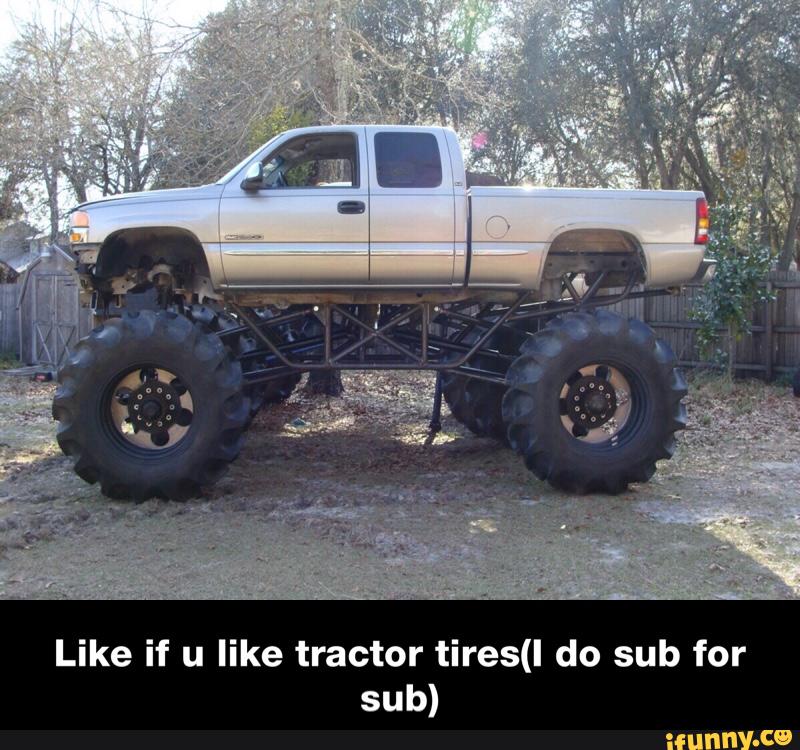 Ginger
Ginger*Part 1* When the tire falls off the rim on the tractor 🚜 I couldn't believe this worked last time! After it worked so well there was no way we couldn't record it this time! #farmlife #tractor #cowgirl #fixit #learning #outonthefarm #redhead #4u #foryou #cowgirlboots
TikTok video from Smokin.Ginger (@smokin.ginger): "*Part 1* When the tire falls off the rim on the tractor 🚜 I couldn't believe this worked last time! After it worked so well there was no way we couldn't record it this time! #farmlife #tractor #cowgirl #fixit #learning #outonthefarm #redhead #4u #foryou #cowgirlboots". original sound.
2392 views|
@thetyrewarrior uses incredible strength to fit tractor tires in the best way possible
57. 6K Likes, 129 Comments. TikTok video from supercarblondie (@supercarblondie): "@thetyrewarrior uses incredible strength to fit tractor tires in the best way possible". original sound - supercarblondie.
6K Likes, 129 Comments. TikTok video from supercarblondie (@supercarblondie): "@thetyrewarrior uses incredible strength to fit tractor tires in the best way possible". original sound - supercarblondie.
873.3K views|
#tractor #farming #farmer #farmlife #explosion #farmtok #johndeere #tire
845 Likes, 24 Comments. TikTok video from Jordy Allen (@jordyallen29): "#tractor #farming #farmer #farmlife #explosion #farmtok #johndeere #tire". 😂😂. original sound.
87.2K views|
Reply to @user104327501 I’ve spent a little time around #BigBud #747 the #worlds #largest #tractor #tractors # farming # agriculture # ag # tractorlovers
9. 1K Likes, 146 Comments. TikTok video from Tyler Price (@tprice323): "Reply to @user104327501 I’ve spent a little time around #BigBud #747 the #worlds #largest #tractor#tractors #farming #agriculture #ag #tractorlovers". original sound.
1K Likes, 146 Comments. TikTok video from Tyler Price (@tprice323): "Reply to @user104327501 I’ve spent a little time around #BigBud #747 the #worlds #largest #tractor#tractors #farming #agriculture #ag #tractorlovers". original sound.
133.2K views|
Tractor tire came off the rim in the mud. Had to improvise. How ranchers workout! #bison #christmas2020 #notcrossfit #georgiagrown #lakeoconee
TikTok video from Georgia Bison Company (@buffaloandrew): "Tractor tire came off the rim in the mud. Had to improvise. How ranchers workout! #bison #christmas2020 #notcrossfit #georgiagrown #lakeoconee". Unrolling round bales for bison.. original sound.
799 views|
by Brian Gorney - Tractor Tire Professional
Being able to understand tractor tires and rim sizes should be straightforward and easy, right? If you have ever had to shop for replacement tires and rims for your tractor, you have probably discovered (the hard way) that the subject of equipment tires isn’t quite as simple as you would think.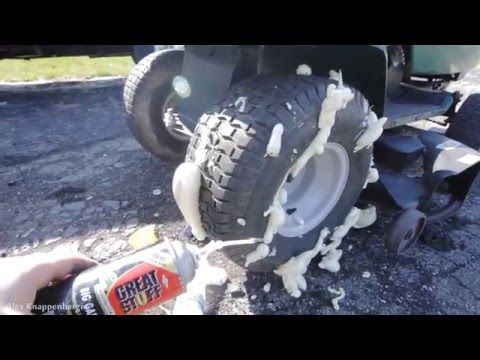 It can be very frustrating for many customers who end up saying to themselves (and sometimes outloud) "I just want a buy a tractor tire and wheel or rim, how hard can that be?" In fact, most people tell me that when shopping for tires online or locally, they often end up with more questions than answers from local tire shops... “What are the rim measurements?” “What is the wheel bolt pattern?” “What is the offset of the wheel?” Honestly, how is anyone who does not size tires and rims for a living supposed to know this information?
It can be very frustrating for many customers who end up saying to themselves (and sometimes outloud) "I just want a buy a tractor tire and wheel or rim, how hard can that be?" In fact, most people tell me that when shopping for tires online or locally, they often end up with more questions than answers from local tire shops... “What are the rim measurements?” “What is the wheel bolt pattern?” “What is the offset of the wheel?” Honestly, how is anyone who does not size tires and rims for a living supposed to know this information?
Luckily, as a Tractor Tire Pro, this is exactly what I do for a living - it is my job to help people every day find exactly the right tires and rims for their tractor, skid steer, trailers, and every other type of equipment. This article explains, in easy to understand terms, exactly how to measure tires, rims, and wheels to help you find the right fit quickly and easily, every time. After reading this article, you will be able to correctly measure not only tractor tires and rims, but every type other type of wheel and tire just like a pro. If you are ready, let’s get started!
If you are ready, let’s get started!
As you may already know, a rim is bolted or fastened to the axle hub on most tractors, skid steers, and other machines that the actual tires mount to. When combined with the tire, it creates what we call the wheel. Obviously, there are many different tires size, therefore there are many different sizes of rims for tire mounting. Tire sizes are most often marked clearly on the side of the tire and are easy to identify. However, if you need a new tire and a new rim for your tractor, machine, or trailer, the tire size itself unfortunately only helps us with half of the answer. To find replacement wheels for your equipment, you will also need to know the rim size and a few other details. These days, most people buy tractor tires online with rims and wheels shipped directly. If you know how to properly measure the rims, when they arrive in 2 to 3 days everything will be a perfect, factory fit.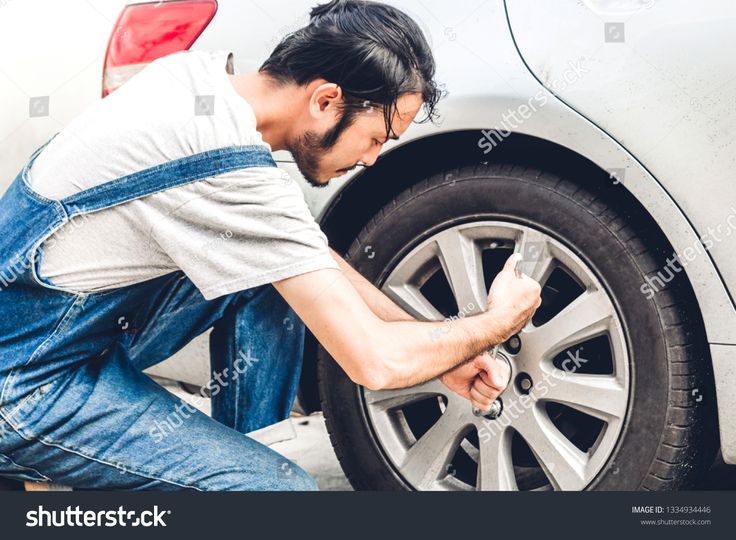
Selecting the right tire and / or tire rim begins with understanding tire itself and the tire size. Depending on the manufacturer and tire application, almost all tires sizes are typically given in either standard size or metric.
Tires Size with two numbers - What they mean
If your tire size has two sets of numbers (10-16.5, 12.4-16, or 18.4R28), here is what the size numbers mean. In our first example of tire size 10-16.5, the first number 10 is the width of the tire in inches. The second number in the example 16.5, is the actual diameter measurement of the wheel that the tire fits. In other words, a 10-16.5 tire is 10” wide and fits a 16.5” rim.
Tire size with three numbers - What they mean
If your tire size has three sets of numbers (18x8.50-8, 31x15. 50-15, or 26x12.00-12) here is what the size numbers mean. In our first example of tire size 18x8.50-8, the first number 18 is the total diameter (outside height) of the tire in inches. The second number in the example 9.50 is the actual width measurement of the tire itself. The third number in the example 8 is the measurement in inches of the rim that this particular tire fits. To sum this up, a 18x8.50-8 tire is 18” inches tall, is 8.5” inches wide, and mounts correctly on an 8” diameter rim.
50-15, or 26x12.00-12) here is what the size numbers mean. In our first example of tire size 18x8.50-8, the first number 18 is the total diameter (outside height) of the tire in inches. The second number in the example 9.50 is the actual width measurement of the tire itself. The third number in the example 8 is the measurement in inches of the rim that this particular tire fits. To sum this up, a 18x8.50-8 tire is 18” inches tall, is 8.5” inches wide, and mounts correctly on an 8” diameter rim.
Step 2: Measuring Your Rim / Wheel Width and Diameter
Let’s first begin with the rim width. The method of correctly measuring the width of a tractor tire rim is from inside the bead lip to the inside of the opposite bead lip. Many tractor and equipment owners make the mistake of incorrectly measuring the overall width of the rim instead, which results in buying a new rim that does not fit the tire.
The measurement of the rim diameter is measured the same way. Remember, the rim diameter it is not measured by overall height, but to the first flange (drop) of the bead lip on the rim itself. There are lots of variations of rim sizes and measurements, so again, check that tire size indicating the rim diameter to make sure they match. One helpful tip is many rim manufacturers will stamp the rim size on the on the inside bead flange, which will tell you what the size of that rim actually is. Most times, the rim diameter will be the first digit and the second will be the rim width or class.
Remember, the rim diameter it is not measured by overall height, but to the first flange (drop) of the bead lip on the rim itself. There are lots of variations of rim sizes and measurements, so again, check that tire size indicating the rim diameter to make sure they match. One helpful tip is many rim manufacturers will stamp the rim size on the on the inside bead flange, which will tell you what the size of that rim actually is. Most times, the rim diameter will be the first digit and the second will be the rim width or class.
The bolt pattern of a wheel or rim is the pattern of lug holes in the rim where the lug bolts / studs and nuts secure the wheel to the tractor or equipment. The lug holes are the points on the wheel that accept the lug nut or lug bolt to securely fasten the wheel to the equipment. There are always at least three bolt holes in a circle around the large hub hole at the center of the wheel, and many times there are more. The “bolt pattern” specifically refers to the layout and distance pattern that the lug nuts are bolted to the wheel or rim.
The “bolt pattern” specifically refers to the layout and distance pattern that the lug nuts are bolted to the wheel or rim.
To measure the bolt pattern, we first need to count the number of bolt holes that are in (or need to be in) the rim and make sure it matches the axle hub. For our purposes, tractor wheels are most commonly equipped 3, 4, 5, 6 and 8 lug bolt patterns, some less common patterns include 5, 7, 10, 11 or more holes. Once you have determined the quantity of bolt holes, you will next measure the distance between the holes themselves.
Tire rim bolt holes are measured center-to-center, meaning you are measuring the distance between the center (the middle) of the hole the center of another hole. When measuring the distance between the bolt holes on any wheel, it is important to keep in mind that that patterns with an even number bolt holes (4, 6, or 8 holes) are a lot easier to measure than patterns with an odd number bolt holes (3, 5 or 7 bolt holes). We cover how to measure odd hole patterns in a moment.
Even Number Bolt Hole Patterns
To measure patterns with an even number of bolt holes, including 4 bolt, 6 bolt, and 8 bolt patterns, you will measure the distance between the bolt holes directly across from each other in a straight line, again, from center to center of two holes. Record this distance.
Odd Number Bolt Hole Patterns
Patterns with an odd number of holes, like 5 bolt patterns, are more difficult to measure because the bolt holes are not directly across from each other. However, we can still measure them effectively. Begin the measurement by using a straight line from the center of any hole, and measure to where the center of where an opposite hole would be if it were there. Because the wheel bolt hole patterns are in concentric circles, this will give you the approximate correct distance between holes center to center and is close enough for our purposes of hole pattern. Record this distance.
Measuring Wheel Bolt Hole Size
Next, you will measure the size (diameter) of the bolt holes themselves, which vary depending on the size of the bolt or the stud.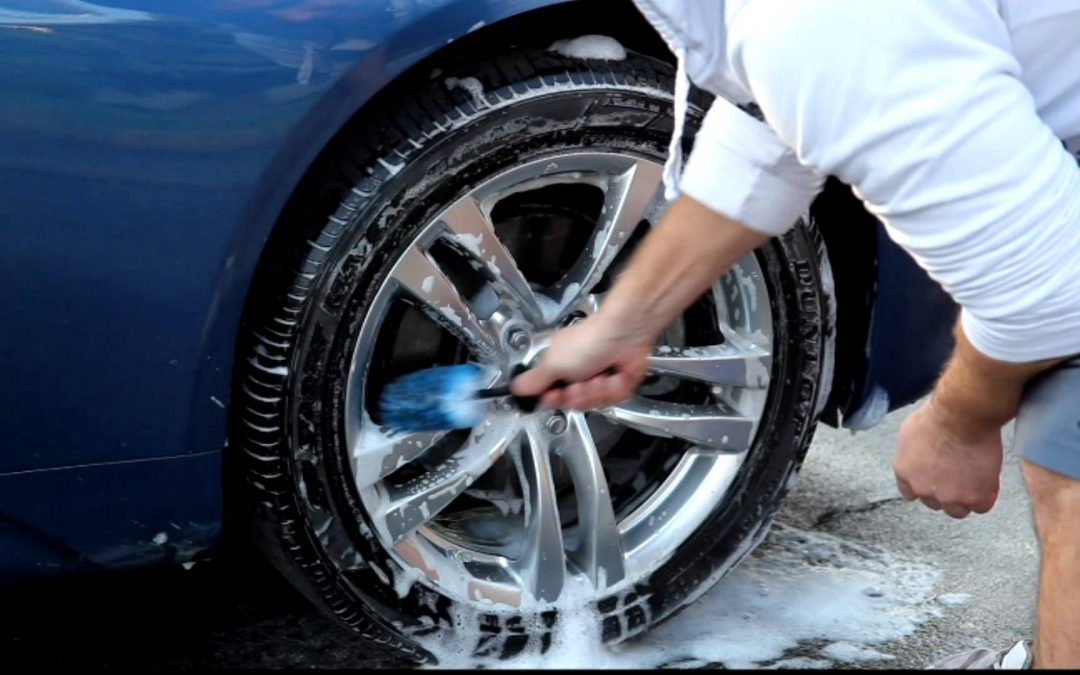 While a tape measure will work moderately well, I recommend measuring with a caliper instead if you can. Again, a tape measure or ruler will still work and get us a close-enough approximation of the size of the holes for us to identify the correct pattern. Record this number.
While a tape measure will work moderately well, I recommend measuring with a caliper instead if you can. Again, a tape measure or ruler will still work and get us a close-enough approximation of the size of the holes for us to identify the correct pattern. Record this number.
While the bolt holes and center hole of any wheel are located exactly in the center of the wheel (if they were not, a wheel would “hop” as it went around), many people also assume that the mounting point of the wheel to the hub (where the bolts holes are) are placed the same distance (with the wheel vertical and mounted to the machine) from the inside of the wheel to outside of the wheel. While this can be correct in certain cases, most often the wheel bolts and mounting center are “Offset” to be wither closer to the inner or outer edge of the wheel ring when mounted to the machine. This offset results in making the wheel either closer or further away from the axle when bolted to the hub.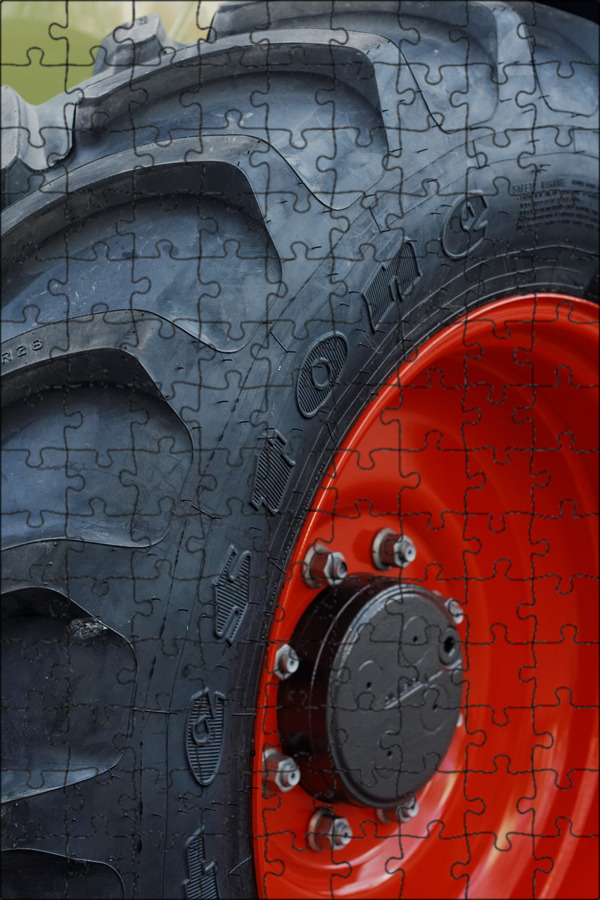 In other words, the Offset of a wheel or rim is the distance (when vertical or in mounted position) from the vertical center of the wheel to where the center of the rim is when mounted to the hub. This difference in distance when mounted is the Offset measurement, and is referred to as either positive, negative, or zero. Positive offset is when the hub mounting surface is more toward the outside of the wheel, making more of the wheel closer to the tractor. Negative offset is when the hub mounting surface is toward the inside (or hub side) of the wheels, resulting in more of the wheel a further distance from the hub or tractor. Zero offset is when the difference in the mounting surface from the inside and the outside of the wheel is the same (equal).
In other words, the Offset of a wheel or rim is the distance (when vertical or in mounted position) from the vertical center of the wheel to where the center of the rim is when mounted to the hub. This difference in distance when mounted is the Offset measurement, and is referred to as either positive, negative, or zero. Positive offset is when the hub mounting surface is more toward the outside of the wheel, making more of the wheel closer to the tractor. Negative offset is when the hub mounting surface is toward the inside (or hub side) of the wheels, resulting in more of the wheel a further distance from the hub or tractor. Zero offset is when the difference in the mounting surface from the inside and the outside of the wheel is the same (equal).
To measure wheel offset, there are a few steps. First the wheel flat. Second, using a ruler or straightedge, measure the distance from the floor or ground to the top of the wheel and record that measurement. Next, divide that measurement by 2. This result is the vertical centerline of the wheel. Next, measure from the hub flange (where the bolt holes are) to the top of the wheel. If the centerline number is smaller than the hub distance to the top of the wheel, the offset is positive; if it is larger, the offset is negative. Finally, subtract the smaller number from the larger number. That result is the actual offset of the wheel.
This result is the vertical centerline of the wheel. Next, measure from the hub flange (where the bolt holes are) to the top of the wheel. If the centerline number is smaller than the hub distance to the top of the wheel, the offset is positive; if it is larger, the offset is negative. Finally, subtract the smaller number from the larger number. That result is the actual offset of the wheel.
Now that you have the wheel width and wheel diameter measurements, bolt pattern measurements, and wheel offset, you are ready confidently buy the correct wheels and tire for your tractor, equipment, or trailer.
More more helpful information, please visit www.TeamTractor.com
Another season of changing shoes is approaching. And you may remember that on one of the tires after the last winter/summer there is a jamb - a small bump. I don’t want to run to the store for the sake of one new tire. We understand. Or maybe it looks even better if repaired?
We understand. Or maybe it looks even better if repaired?
Yes, not every wheel that has met with a nail, rebar sticking out of the ground or a sharp stone on the road is considered damaged. Everything, of course, depends on the scale of the damage and its location on the tire itself. Some are easily repaired, while others are simply impossible to do - the tire can only be sent to the trash.
A bulge on a wheel, referred to by drivers as a bump or bulge, is the most common tire sidewall defect. It appears due to a collision with an obstacle or after falling into a pit, more often at high speed. The threads of the sidewall carcass are easily damaged by impact, and the tire at this point can no longer hold the load and air pressure - swelling appears. A small bump sooner or later turns into a big one, and driving with such a defect is dangerous - the wheel can shoot at any moment. At high speed, this is fraught with loss of control, departure from the road and a rollover.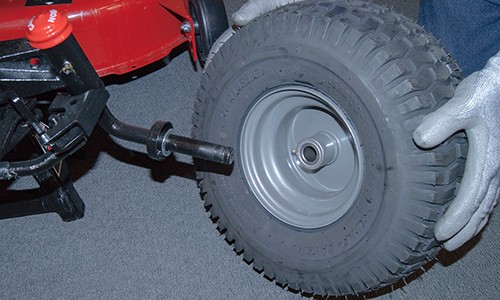
The quality of roads in Kazakhstan contributes to the appearance of bulges on tires
Some types of bulges are repairable, although this is a temporary measure. Not a single patch can restore the factory rigidity. Ideally, change the tire.
Special cord patches can extend the life of a tire with a herniation, even if the swelling has appeared on the tread. The sidewall is a different story. If the swelling appeared at a distance of more than 40 mm from the side, it can be repaired. If not, then the wheel needs to be replaced. Blisters on low profile tires are most often non-repairable.
For maximum safety when riding with a repaired bump, insert the tube. This is an inexpensive and reliable solution. On our market, you can find cameras made in China and Russia, the latter are slightly more expensive, but also of better quality.
The elimination of a side cut is a serious operation, therefore, as in the case of a bump, you will have to go to the professionals. We need cord patches, fortunately in our time they are of different sizes and with a different number of layers. And if you do it wisely, then you can't do without special tools and vulcanization.
We need cord patches, fortunately in our time they are of different sizes and with a different number of layers. And if you do it wisely, then you can't do without special tools and vulcanization.
A cut, by the way, cannot be healed in all cases. If the gap is in the shoulder area of the tire, it is unlikely that anyone will undertake to repair it, since no guarantees can be given here. However, our Kulibins take on even the most difficult cases, cutting out parts of the sidewalls from the tires and even weaving the cord on their own.
Tire overhaul. We would not put such a wheel on ourselves
Low profile tires can be repaired, but more difficult. A tear in the sidewall is easier to seal on tires with a medium or high profile.
Sometimes a cut is confused with a pluck. This is when the outer layer of the sidewall caught on something sharp, a tear formed, but the frame itself remained intact. There is nothing wrong with that, although the drivers at the tire fitting company successfully repair the cut, for which they take it accordingly.
If a piece of rubber remains on the sidewall, then glue it with ordinary superglue (101st). If it came off, then it is better to cover it with raw rubber and vulcanize. Leaving the pluck bare is not recommended, because the tire carcass, often consisting of a metal cord, will quickly corrode.
In Europe, defective or used tires are perforated before being sent for scrap to prevent their resale and possible operation. But they don’t know that we have such holes on the sidewall patched once or twice
Cuts and hernias are not the only possible damage to the side of the tire. You can also spoil the side ring, in the process of changing shoes, for example. If it’s for garlic, then such a tire is already dangerous. Sooner or later, the tire pressure and the load in motion will start to squeeze the rubber off the rim - a wheel explosion can occur.
This ailment is repaired if the wire ring - the base - is intact.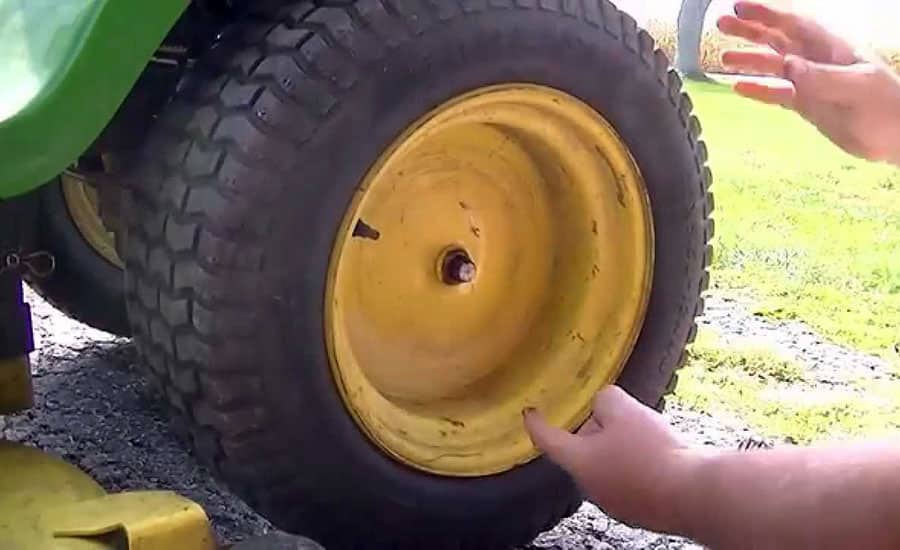 There are no special technologies and materials to correct this particular problem, but most often craftsmen use a two-component composition for chemical (also called cold) vulcanization. After mixing, the mass is pressed into a fat-free damage. Compound manufacturers recommend waiting 72 hours before mounting a tire. Of course, our masters do not pay attention to this condition - they put the tire right away. And it’s good if the wheel is flat because of this at night in the parking lot, and not on the road.
There are no special technologies and materials to correct this particular problem, but most often craftsmen use a two-component composition for chemical (also called cold) vulcanization. After mixing, the mass is pressed into a fat-free damage. Compound manufacturers recommend waiting 72 hours before mounting a tire. Of course, our masters do not pay attention to this condition - they put the tire right away. And it’s good if the wheel is flat because of this at night in the parking lot, and not on the road.
If the side ring tears are barely noticeable, but the wheel still deflates, then you can use a special liquid - a bead seal designed to seal a tubeless tire.
These seals have been used in motorsport for some time. In particular, in the American Formula D Drift Series, drivers used compounds to keep the tire on the rim even with minimal tire pressure. Now they are banned.
Pay attention to the left rear wheel of the Nissan Silvia S13. Due to too low pressure, it was literally taken off the disk under load
Every schoolchild has faced this problem when patching the inner tube of his bike after hitting something sharp. Repairing a car tire puncture with your own hands will also not be difficult even on the road. But for this you will need a pump (or compressor) and a universal tire repair kit with harnesses. All this is sold at any car market or gas station.
Repairing a car tire puncture with your own hands will also not be difficult even on the road. But for this you will need a pump (or compressor) and a universal tire repair kit with harnesses. All this is sold at any car market or gas station.
Repairing a tire on the side of the road with harnesses
The process is simple. If we are talking about the front wheels, then in most cases the wheel can not even be removed, it is enough to turn the steering wheel in the right direction, find the puncture site and carry out repairs. First, the hole is cleaned with a helical awl from the set. The tourniquet itself is smeared with glue and tucked into the eye of the awl, after which it is inserted into the tire hole. With a sharp movement, the tool is removed, and the tourniquet remains in place and clogs the hole. The tails are cut with a knife, but not at the root, it is recommended to leave about 20 mm. The tire is inflated and checked.
Sometimes a nail or self-tapping screw clogs the hole by itself, remaining in it. If you see a hat in a tread, do not rush to pull it out. While the pressure is holding, move to vulcanize. And sometimes they drive with a screw in a tire for weeks.
If you see a hat in a tread, do not rush to pull it out. While the pressure is holding, move to vulcanize. And sometimes they drive with a screw in a tire for weeks.
Repair of a puncture at a tire shop
Punctures are also repaired with harnesses at a specialized service, although among professionals such repairs are not considered long-term. After a few months, the flagella dry out and can let air through. There are more advanced methods like cold and hot vulcanization. The latter is more reliable. In this case, the hole is sealed with an elastic patch, and the funnel from a foreign object is filled with a special compound. After that, a vulcanizer is put on the tire, it heats up the rubber and solders it.
In addition to the plaster, the puncture is also repaired with special cord fungi. Craftsmen process the puncture site: drill it and treat the surface with a tool to roughen it. Then the repair area is lubricated with glue (it is also called cement) and a fungus is introduced. This is done from the inside of the tire. The cap of the fungus is rolled, and the excess legs are simply cut off from the outside.
This is done from the inside of the tire. The cap of the fungus is rolled, and the excess legs are simply cut off from the outside.
Puncture repair with sealant
With the advent of tubeless wheels, and later run flat tires, many automakers began to abandon spare wheels. Instead, repair kits with compressors are supplied with the machines. A repair kit is essentially a bottle of pressurized sealant. Later, such spray cans began to appear on the shelves of ordinary car dealerships.
This method has not taken root in the CIS, because the condition of the roads makes it necessary to have at least a stowaway in the kit, but it can also be considered as a method of repair on the road.
The car must be jacked up and sealant must be pumped into the damaged wheel through the nipple. Next, you should spin the wheel, then pump it up, lower the car and drive a few hundred meters.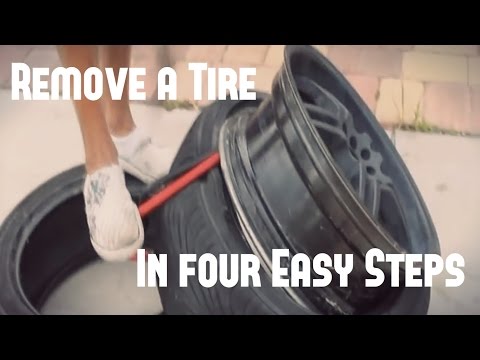 If the tire tightness has not been restored, repeat the procedure.
If the tire tightness has not been restored, repeat the procedure.
For commercial vehicles, cutting the tread with a special device (regrower) is a common thing. Moreover, such tire retreading is provided by the factory (marked REGROOVABLE on the sidewall) to increase the service life. But there are entrepreneurs who undertake to deepen the grooves in tires for passenger cars. But they are not intended for such an operation. Often used tires for sale are “refreshed” in this way. Be careful!
What is the threat?
The worst option is that the retreaded tire will shoot out on the road, as the master can damage the undertread layer when deepening the grooves. Such a tire will not be able to hold pressure at some point. There will be a boom! At best, the tire will indeed last a little longer, but is the game worth the candle? We think it's not worth it.
How is cutting made?
A regrower is used to cut the tread. Roughly speaking, this is a large soldering iron with interchangeable tips of various shapes. It goes through rubber like a knife through butter.
Roughly speaking, this is a large soldering iron with interchangeable tips of various shapes. It goes through rubber like a knife through butter.
If the tire is for passenger cars, then it is worth taking on a regrower only in one case - when part of the tread pattern was welded with "new" rubber during repair. This is where threading comes in handy in order to restore the grooves and symmetry of the tread.
Vehicle operation is prohibited if:
- tires have a residual tread height of less than 1.6 mm;
- tires have punctures, cuts, ruptures that expose the cord, as well as delamination of the carcass, delamination of the tread and sidewall;
- tires in size or load capacity do not match the car model;
- tires of various sizes, designs (radial, diagonal, chamber, tubeless), models, with different tread patterns, winter and summer, studded and non-studded, new and restored, are installed on one axle of the car;
- Tires retreaded according to the second repair class are installed on the front axle.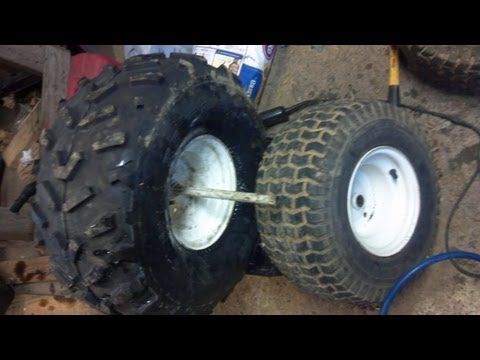
What is a second class repair?
This is the case when the carcass of the tire is restored after serious damage. A side cut (or tear) is a serious damage to the tire carcass.
Use and store tires in accordance with the rules for operating tires for tractors and agricultural machines.
Only fit tires, inner tubes and rims that are in good working order and of the correct size and type (Fig. 20). The rims must not have mechanical damage, bends, crumpled edges, burrs, must be cleaned of rust and painted. Tires must be clean and dry. Sprinkle with talcum powder before mounting tires and tubes.
Mounting and dismounting of the tractor wheels is carried out by two workers using two mounting blades.
The first blade is a lever, one end of which is made in the form of a fork and serves only to remove the tire beads from the rim shelves, and the other end serves to mount the tire. The second blade has one end in the form of a curved profile, which provides a reliable grip on the rim flange, as well as the removal of the tire beads from the rim shelves in tandem with the fork end of the first blade, the other end is a socket wrench for the locking screw of the hydraulic jack. When mounting the tire, pay attention to the fact that when installing the wheel on the tractor, the direction of rotation of the wheel coincides with the arrow on the tire. Mounting and dismounting, insertion of the tire beads are possible only when the diametrically opposite part of the tire with respect to the refueling bead is recessed into the rim stream. Applying a soapy solution to the tire beads during mounting and dismantling greatly facilitates mounting and dismounting, and increases the service life of the tires.
Fig. 20. Tire, chamber and wheel rim of the tractor
Mount the tire on the rim in the following order (Fig. 21):
the tire bead has entered the rim creek;
2) Insert the first spatula between the top bead and the rim so that the curved end securely grips the bead and, acting as a lever, slide the bead to be mounted over the rim flange. Repeat this operation several times until the installation of the mounted board does not cause difficulties;
3) use a second spatula to facilitate further assembly. Insert it between the tire bead and the rim and press the rim up, insert the other blade closer to the wound tire bead and repeat the previous operation. Sequentially moving along the circumference, repeat this operation several times until the rim flange enters the tire cavity;
4) drive the last section of the rim into the tire by gently pressing two paddles simultaneously;
5) place the tire obliquely against the wall, press the rim against the wall so. so that the cavity of the tire is completely freed, and, taking the chamber from the side of the valve, insert it into the cavity of the tire;
so that the cavity of the tire is completely freed, and, taking the chamber from the side of the valve, insert it into the cavity of the tire;
6) insert the valve into the valve hole and secure it with a nut, while making sure that the valve is in the correct position, do not allow it to be tilted: Put the inner tube completely on the rim, push the rim towards you and inflate the inner tube to exclude the possibility of pinching the inner tube between the tire beads and rim;
7) put the tire on the floor. On the opposite side of the valve, insert both mounting blades at a distance of 250-300 mm from one another so that they securely grip the rim flange, and, pressing the blades down, slide the tire bead over the rim flange;
8) holding one paddle in this position, pull out the second paddle and insert it at a distance of 50-100 mm from the first one so that it captures the bead, and, pressing the paddle down, push the tire bead over the rim bead. Mounting is greatly facilitated if you press the tire with your foot at the same time. In order to facilitate the process of inserting the upper bead of the tire, sink the part of the tire opposite to the refueling bead into the rim stream with your feet;
In order to facilitate the process of inserting the upper bead of the tire, sink the part of the tire opposite to the refueling bead into the rim stream with your feet;
Fig. 21. Fitting the bar
9- installation ends at the valve with two blades;
Fig. 22. Removing the tire
Inflate the tire to normal pressure, then completely deflate the tire and inflate again to a pressure of 0.28 MPa (2.8 kgf/cm2), maintaining this pressure until the tire beads land on the rim shelves; then let the air out until the recommended tire pressure is reached. Inflate tires in a protective mesh (zone).
Remove the tire from the rim in the following order (Fig. 22):
- let the air out of the tire completely;
- Remove the tire beads from both tapered rim flanges using the fork end of the first blade and the curved end of the second blade. Remove the beads first from the shelf opposite the valve hole, in the following order:
1) insert the bent end of the second blade between the rim bead and the tire and press the tire bead down;
2) insert the forked end of the first blade into the gap formed between the rim flange and the tire so that the bent end of the second blade is in the groove of the fork blade;
3) Press the tire bead down with the first mounting spatula.